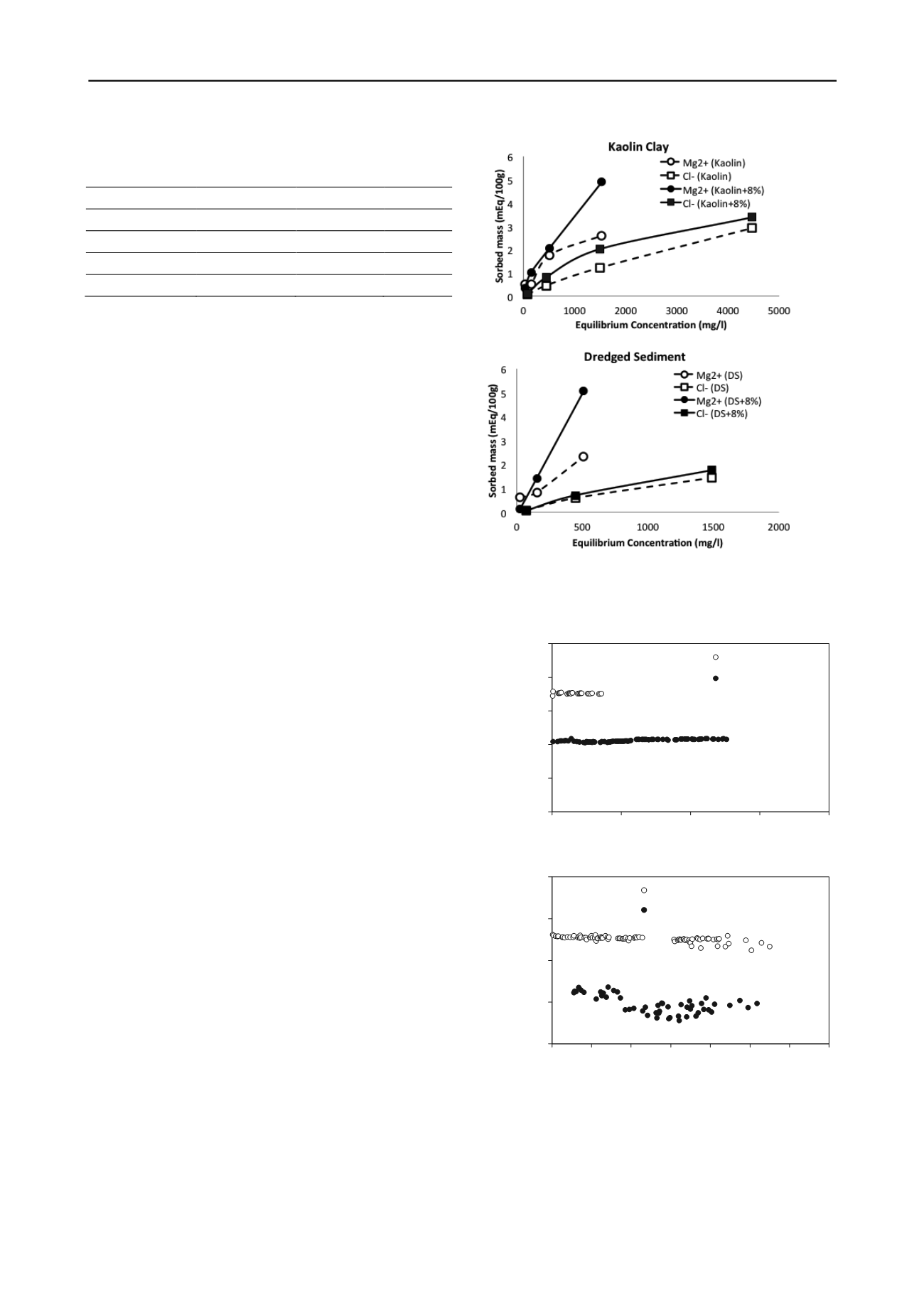
3193
Technical Committee 307 /
Comité technique 307
Proceedings of the 18
th
International Conference on Soil Mechanics and Geotechnical Engineering, Paris 2013
3
Table 3. Chemical properties of the MgCl
2
solutions used for the Batch
Sorption test
MgCl
2
(mg/L)
EC (mS/cm)
Salinity (-)
pH
100
0.301
0.0
6.87
200
1.382
0.5
7.04
2000
4.16
2.1
7.3
6000
12.13
6.46
7.7
3.2
Hydraulic conductivity test
Flexible wall hydraulic conductivity tests were conducted in
order to investigate the impact of 8% of polymer addition on the
hydraulic performance of the soils to a high concentrated
electrolyte solution (natural seawater). The hydraulic
conductivity tests were performed with an average effective
stress of 30 kPa on 10 cm diameter samples with an initial
porosity of about n = 0.718 (kaolin) and n = 0.542 (dredged
sediment). To prepare the kaolin samples, the untreated and
treated soil were poured dry in a stainless steel ring (0,45g/cm²,
as a standard GCL, 10 cm diameter) with a fixed height between
two porous stones and submerged with seawater, with a sitting
weight on top, for about one week. The dredged sediment
sample was prepared by standard proctor compaction (ASTM
D0698) with a water content two points higher than the
optimum, to simulate a Compacted Clay Liner.
4
RESULTS AND DISCUSSION
4.1
Batch sorption test results
Figure 1 shows the sorption isotherms of the treated and
untreated kaolin (a) and of the treated and untreated dredged
sediment (b). The adsorbed mass of ions is plotted here vs. the
equilibrium concentration of the MgCl
2
solutions. As shown in
the graphs, batch sorption test results demonstrate that the
sorbed mass of magnesium cations is higher onto the polymer
treated soil compared to the untreated soil.
4.2
Hydraulic conductivity test results
Figure 2 shows the hydraulic conductivity test results of the
treated and untreated soils. As shown in Figure 2.a, the
hydraulic conductivity to seawater of the kaolin treated with 8%
of the polymer was lower compared to that of the kaolin treated
with 2% of the polymer. This result demonstrates that the
hydraulic performance of a kaolin clay as barrier increases with
increasing polymer dosage.
Figure 2.b shows that the hydraulic conductivity to seawater
of the dredged sediment treated with 8% of the polymer is
nearly two orders of magnitude lower compared to that of the
untreated dredged sediment.
(a)
(b)
Figure 1. Sorption isotherms of kaolin (a) and dredged sediment, DS (b)
1.E-12
1.E-11
1.E-10
1.E-09
1.E-08
1.E-07
0
50
100
150
200
Hydraulic conductivity [m/s]
Time [days]
kaolin + 2% CMC
kaolin + 8%CMC
(a)
1.E-12
1.E-11
1.E-10
1.E-09
1.E-08
0
50 100 150 200 250 300 350
Hydraulic conductivity [m/s]
Time [days]
Dredged Sediment
Dredged Sediment + 8%CMC
(b)
Figure 2. Hydraulic conductivity test results of (a) kaolin clay 2% CMC
and 8% CMC, and (b) dredged sediment and dredged sediment treated
with 8% CMC, permeated with natural seawater


